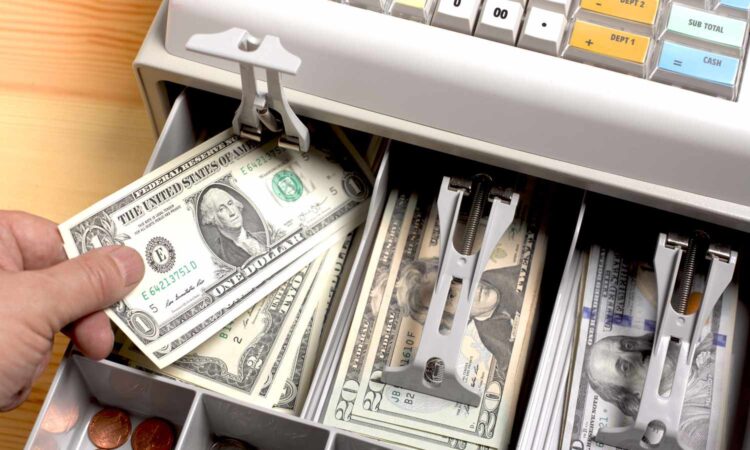
The Federal Reserve has taken two extraordinary steps this month to calm investors and ensure money keeps flowing through the global economy amid rising concerns about the stability of the banking system.
They also likely will bolster the status of a longtime global champion: the U.S. dollar.
KEY TAKEAWAYS
- The Federal Reserve has moved swiftly in response to concerns regarding the U.S. banking system.
- It took similar steps during the global financial crisis and the Covid-19 pandemic.
- Aside from their stated intent, emergency programs will likely boost the U.S. dollar’s already-dominant role in global commerce.
Since March 12, the Fed has initiated a bank funding program and coordinated with other global central banks to enhance global liquidity. Doing so aims to reassure investors, depositors and financial institutions in the wake of two large U.S. regional bank failures and the takeover of Credit Suisse by rival UBS.
Aside from their stated intent, however, those moves likely will enhance the U.S. dollar’s role—one it has possessed since World War II—as the world’s primary reserve currency and means of transaction.
Collateral Damage
“Nothing like a crisis to vividly illustrate the elasticity of the global dollar system and reinforce demand for dollar-denominated assets,” David Beckworth, senior research fellow at George Mason University’s Mercatus Center for financial markets research, wrote in a tweet following the Fed’s latest move.
For the past year, the Fed has raised interest rates without ceasing as it tries to reduce the highest U.S. inflation rate in four decades. Other central banks have done the same, again this week reiterating their commitment to reducing inflation.
The Fed increased its benchmark rate Wednesday by 25 basis points to 4.75%-5%. The Bank of England followed today with a rate hike of 25 bps, Norway’s Norges Bank raised its benchmark rate by 25 bps and the Swiss National Bank raised its benchmark rate by 50 bps.
Rate hikes have succeeded somewhat in slowing inflation but have yielded collateral economic damage, including turmoil in the global banking system.
Steadying the Ship
A week after the Fed unveiled a program providing funds to keep U.S. banks solvent, it said Sunday it would work with the world’s five other large developed market central banks to enhance global liquidity.
Those same banks—the Fed, the European Central Bank, the Bank of Japan, the Bank of England, the Bank of Canada and the Swiss National Bank—worked together in a similar fashion during the global financial crisis in 2008 and again during the early months of the Covid-19 pandemic in 2020.
Combined, some view the moves as tantamount to pushing the U.S. dollar to the rescue.
Some economists long have predicted that rising U.S. debt, China’s increasing share of the global economy and other factors could threaten the dollar’s stature as the world’s reserve currency.
However, Beckworth said on Twitter the Fed’s latest moves will “further strengthen the global dollar system and its powerful network effects,” reducing the chances of any alternative global currency system gaining traction.
What the Fed Did
Sunday’s action will increase the use of U.S. dollar credit facilities known as “swap lines” among central banks. Swaps are financial derivatives in which two parties—in this case, the central banks— exchange a series of cash flows for a set period of time.
Essentially, by increasing the use of their swap lines to a daily from a weekly basis, the central banks have agreed to boost the flow of U.S. dollars within the global financial system.
Those central banks did the same briefly during the pandemic, reinstituting a program initiated during the global financial crisis.
The Fed’s announcement Sunday came one week after it opened a Bank Term Funding Program targeting cash injections into the U.S. banking system. The Fed unveiled that program in response to the failure of two large regional banks, Silicon Valley Bank and New York-based Signature Bank.
Currently, the U.S. banking system has about $3 trillion in cash reserves. J.P. Morgan analysts estimated the funding program could add as much as $2 trillion in additional reserves to that amount. That potential supply increase could pressure the dollar’s value, even as the Fed’s support of banks and financial markets underpins it.
The U.S. Dollar Index, measured against a basket of other currencies, rose 1.5% immediately after the Fed’s move a week ago but has fallen 2.5% from its 2023 peak established two weeks ago.
The Dominant Dollar
If the Fed’s attempt to increase the amount of U.S. dollars in the U.S. banking system while boosting the flow of dollars within global financial markets succeeds, it seemingly would buttress the dollar’s already dominant position.
Down from 71% in 2000, the U.S. dollar accounts for 60% of all global foreign exchange reserves. It also accounts for more than 75% of all trade outside of Europe, about 60% of all international deposits and loans—three times as much as the second-place euro—and 60-65% of all non-U.S. debt issuance.
In addition, buyers around the world pay for global commodities—ranging from crude oil to wheat—in U.S. dollars because most price benchmarks reflect dollar-based measurements. About half the world’s gross domestic product comes from countries anchored to the dollar—10 times more than those anchored to the euro.
Meanwhile, the share of U.S. dollar banknotes as a percentage of all foreign currency holdings has increased to about 45% today from 35-40% in 2000. The Fed’s recent actions may buoy that percentage—further entrenching the dollar’s supremacy.



